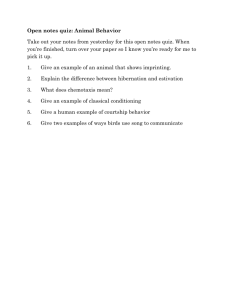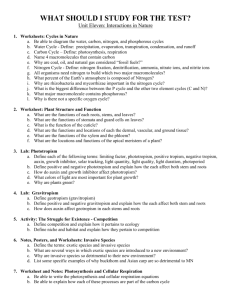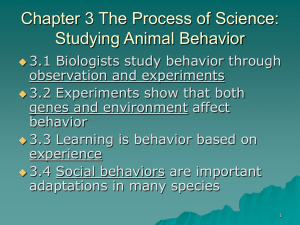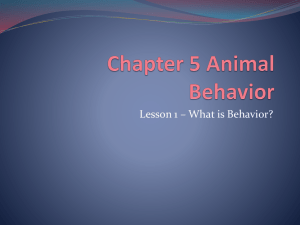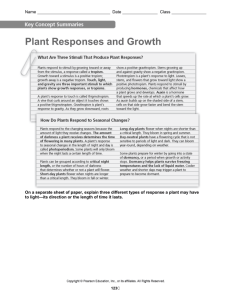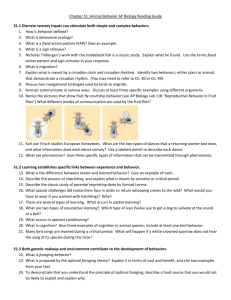Ch. 39/51 Study Guide
advertisement
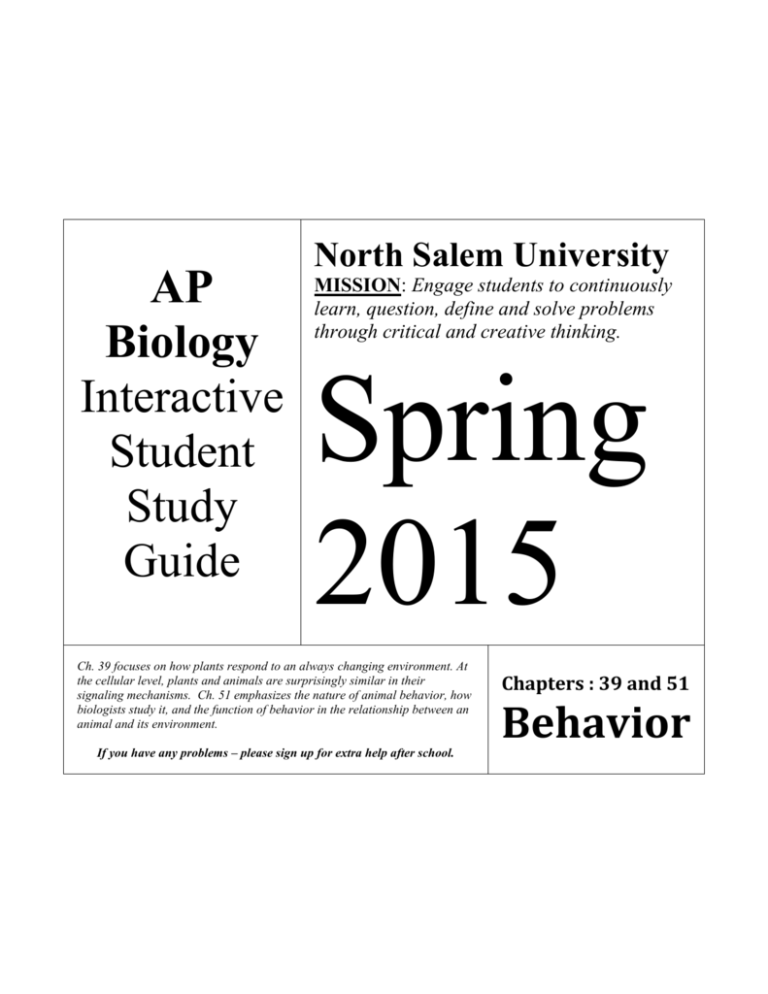
AP Biology Interactive Student Study Guide North Salem University MISSION: Engage students to continuously learn, question, define and solve problems through critical and creative thinking. Spring 2015 Ch. 39 focuses on how plants respond to an always changing environment. At the cellular level, plants and animals are surprisingly similar in their signaling mechanisms. Ch. 51 emphasizes the nature of animal behavior, how biologists study it, and the function of behavior in the relationship between an animal and its environment. If you have any problems – please sign up for extra help after school. Chapters : 39 and 51 Behavior Chapter 51: Behavioral Biology OBJECTIVES: __1. __2. __3. __4. __5. __6. __7. Introduction to Behavior and Behavioral Ecology Define behavior. Distinguish between proximate and ultimate questions about behavior. Explain how genes and the environment contribute to behavior. Explain what is unique about innate behavior. Define fixed action patterns and give examples in fish and humans. Describe the evolutionary basis for behavioral ecology. Explain why it is useful to use evolutionary principles as a guide to behavioral research. Learning Explain how learning, maturation, and habituation influence behavior. Define imprinting and explain the importance of the sensitive period. Illustrate these concepts using examples from bird song. __10. Distinguish between classical conditioning and operant conditioning. __11. Define play and describe several possible adaptive advantages of this behavior. __8. __9. Animal Cognition __12. Describe the ultimate bases of learning. __13. Describe and illustrate with examples kinesis, taxis, and migration. Social Behavior and Sociobiology __14. Relate an animal's mode of communication to its lifestyle. __15. Explain how honeybees communicate information about the location of sources of food. KEY TERMS: associative learning conditioning foraging kinesis sensitive period taxis behavior cognition habituation learning sign stimulus behavioral ecology courtship imprinting pheromone signal classical fixed action pattern kin selection operant conditioning social behavior -------------------------------------WORD ROOTS: agon- = a contest (agonistic behavior: a type of behavior involving a contest of some kind that determines which competitor gains access to some resource, such as food or mates) andro- = a man (polyandry: a polygamous mating system involving one female and many males) etho- = custom, habit (ethology: the study of animal behavior in natural conditions) gyno- = a woman (polygyny: a polygamous mating system involving one male and many females) kine- = move (kinesis: a change in activity rate in response to a stimulus) mono- = one; -gamy = reproduction (monogamous: a type of relationship in which one male mates with just one female) poly- = many (polygamous: a type of relationship in which an individual of one sex mates with several of the other) socio- = a companion (sociobiology: the study of social behavior based on evolutionary theory) 2 Guided Reading: Chapter 51 1. How do behavioral ecologists define behavior? 2. What is the focus of: a. Proximate questions of behavior? b. Ultimate questions of behavior? 3. What influences behavior more: genes or the environment? (nature) (nurture) 4. Define, give three examples of, and explain how innate behaviors could have evolved? 3 5. What is the relationship between a fixed action pattern (FAP) and a sign stimulus? 6. Briefly describe Niko Tinbergen’s experiment on innate behavior using stickleback fish. 7. What is behavioral ecology? 8. What is learning? 9. How do the alarm calls of vervet monkeys provide an example of how animals improve a behavior by means of learning? 10. Define habituation and explain how it helps the overall fitness of an organism. 4 11. Briefly describe Konrad Lorenz’s imprinting experiment using graylag geese being sure to use the term sensitive period in your answer. 12. Briefly describe Ivan Pavlov’s classical conditioning experiment using dogs. 5 13. What is the difference between classical conditioning and operant conditioning? 14. What is cognition? 15. Compare and contrast and give specific examples of kinesis and taxis. 16. What is the relationship between migration and genetic control? 17. How are the terms signal and communication related? 18. Describe and give three different examples of animal signals and communication. 6 19. What are phermones and give three examples of pheromone use by animals. 20. Use the diagram below to explain how honeybees communicate information about the location of sources of food. 7 Chapter 51: Summary of Key Concepts INTRODUCTION TO BEHAVIOR AND BEHAVIORAL ECOLOGY What is behavior? (p. 1122) Behavior mainly consists of observable muscle-powered movements. Behavior has both proximate and ultimate causes (p. 1122) Proximate mechanisms include the hormonal, nervous, and environmental stimuli that elicit a particular behavior pattern during the life of an animal. Ultimate causes are the reasons why the behavior pattern evolved over evolutionary time. Behavior results from both genes and environmental factors (p. 1122-1123, FIGURE 51.1) An individual’s behavior develops under the influence of genes and environment. Innate behavior is developmentally fixed (pp. 1123-1124) An innate behavior is one that occurs in all individuals of a population, regardless of individual differences in experience. Classical ethology presaged an evolutionary approach to behavioral biology (pp. 1124-1126, FIGURES 51.2-51.4) Early ethologists focused on fixed action patterns (FAPs), essentially unchangeable series of acts usually carried to completion once triggered by an external sensory stimulus (sign stimulus). Behavioral ecology emphasizes evolutionary hypotheses (pp. 1126-1128, FIGURES 51.5-51.7) Behavioral ecology is based on the theory that animals behave in ways that increase their Darwinian fitness (reproductive success). LEARNING Learning is experience-based modification of behavior (pp. 1128-1129, FIGURE 51.8) Learning is modification of behavior resulting from specific experiences. Some apparent learning is due mostly to inherent maturation. Habituation is a simple kind of learning involving loss of sensitivity to unimportant stimuli. Imprinting is learning limited to a sensitive period (pp. 1129-1130, FIGURE 51.9) Imprinting occurs in various animals and can involve the identity of mating partners as well as of parents. Bird song provides a model system for understanding the development of behavior (pp. 1130-1132, FIGURE 51.10) Biologists have described two forms of development of bird song: learning during a sensitive period (as in the whitecrowned sparrow); and open-ended learning (as in the canary), in which the bird continually adds new components to its song each year. Many animals can learn to associate one stimulus with another (p. 1132, FIGURE 51.11) Associative learning involves linking one stimulus with another. In operant conditioning, or trial-and-error learning, an animal learns to associate one of its own behaviors with reward or punishment and modifies the behavior accordingly. Practice and exercise may explain the ultimate bases of play (pp. 1132-1133, FIGURE 51.12) The benefits of play may include the practice of survival behaviors, such as hunting, as well as fulfilling the need for exercise. ANIMAL COGNITION The study of cognition connects nervous system function with behavior (pp. 1133-1134, FIGURE 51.13) Cognition is the ability of an animal’s nervous system to perceive, store, process, and use information gathered by sensory receptors. Animals use various cognitive mechanisms during movement through space (pp. 1134-1136, FIGURES 51.14-51.16) Many animals find their way around in space by means of memorized landmarks. Some migrating birds and other animals navigate by calibrating several cues: Earth’s magnetic field, the sun, and the stars. SOCIAL BEHAVIOR AND SOCIOBIOLOGY Sociobiology places social behavior in an evolutionary context (p. 1137) Social behavior encompasses the spectrum of interactions between two or more animals, usually of the same species. Natural selection favors mating behavior that mazimizes the quantity or quality of mating partners (pp. 1140-1142, FIGURES 51.23-51.25) Courtship functions to identify that two individuals are of the same species and are ready to breed. The full elaboration of courtship is due to sexual selection, particularly female choice. During courtship, a male may display his genetic quality and (in species with parental care) his readiness for parental care. The mating system of a species consists of the way in which males and females associate for breeding; mating systems may be promiscuous, monogamous, or polygamous, depending partly on the parental investment made by males and females. Social interactions depend on diverse modes of communication (pp. 1142-1144, FIGURES 51.26, 51.27) Animals communicate by means of signals, in which the behavior of one individual leads to a change in the behavior of another individual. Web/CD Activity51A: Honeybee Waggle Dance Video 8 Chapter 39: Plant Responses OBJECTIVES: __1. __2. __3. Signal Transduction and Plant Responses Describe the signal transduction pathway. Describe the role of second messengers in the signal transduction process. Describe the two main mechanisms by which a signaling pathway can activate an enzyme. __4. Plant Responses to Hormones Explain how a hormone may cause its effect on plant growth and development. __5. __6. __7. __8. __9. __10. __11. __12. __13. Plant Responses to Light Define circadian rhythm and explain what happens when an organism is artificially maintained in a constant environment. List some common factors that entrain biological clocks. Define photoperiodism. Distinguish between short-day, long-day, and day-neutral plants. Explain why these names are misleading. Explain how flowering might be controlled and what is necessary for flowering to occur. Plant Responses to Environmental Stimuli Other than Light Describe how plants apparently tell up from down. Explain why roots display positive gravitropism and shoots exhibit negative gravitropism. Distinguish between thigmotropism and thigmomorphogenesis. Describe the challenges posed by, and the responses of plants to, the following environmental stresses: drought, flooding, salt stress, heat stress, and cold stress. Plant Defense: Responses to Herbivores and Pathogens __14. Explain how plants deter herbivores with physical and chemical defenses. KEY TERMS: auxins gibberellins secondary messenger circadian rhythm hormone thigmomorphogenesis cytokinins photoperiodism thigmotropism ethylene phototropism tropism -------------------------------------WORD ROOTS: aux- = grow, enlarge (auxins: a class of plant hormones, including indoleacetic acid, having a variety of effects, such as phototropic response through the stimulation of cell elongation, stimulation of secondary growth, and the development of leaf traces and fruit) circ- = a circle (circadian rhythm: a physiological cycle of about 24 hours, present in all eukaryotic organisms, that persists even in the absence of external cues) photo- = light; -trop = turn, change (phototropism: growth of a plant shoot toward or away from light) phyto- = a plant; -alexi to ward off (phytoalexin: an antibiotic, produced by plants, that destroys microorganisms or inhibits their growth) thigmo- = a touch; morpho- = form; -genesis = origin (thigmomorphogenesis: a response in plants to chronic mechanical stimulation, resulting from increased ethylene production; an example is thickening stems in response to strong winds) zea- = a grain; -xantho = yellow (zeaxanthin: a blue light photoreceptor involved in stomatal opening. 9 Guided Reading: Chapter 39 21. Label the diagram below to review (for the 5th time this year) the general model for a signal transduction pathway. 22. Define circadian rhythm and explain what happens when an organism is artificially maintained in a constant environment. 23. List some common factors that entrain biological clocks. 24. Define and give an example of photoperiodism. 10 25. Explain how flowering might be controlled and what is necessary for flowering to occur. 26. Describe how plants apparently tell up from down. 27. Explain why roots display positive gravitropism and shoots exhibit negative gravitropisms. 28. Distinguish between thigmotropism and thigmomorphogenesis. 29. Describe the responses of plants to the following environmental stresses: Environmental Stress Plant Response drought flooding dsalt stress heat stress cold stress 11 30. Use to diagram below to help explain how a corn leaf deters herbivores with physical and chemical defenses. 12 Chapter 39: Summary of Key Concepts SIGNAL TRANSDUCTION AND PLANT RESPONSES Signal-transduction pathways link internal and environmental signals to cellular responses (pp. 803-806, FIGURES 39.1-39.3) Hormones and environmental stimuli interact with specific receptors, thereby activating specific signal transduction pathways and inducing cellular responses. PLANT RESPONSES TO HORMONES Research on how plants grow toward light led to the discovery of plant hormones (pp. 806-807, FIGURES 39.4, 39.5) Researchers discovered auxin by identifying the compound responsible for transmitting a signal downward through coleoptiles, from the tips to-the elongating regions during phototropism. Plant hormones help coordinate growth, development, and responses to environmental stimuli (pp. 808-817, TABLE 39.1, FIGURES 39.6-39.16) This review cites one major function of each hormone. Produced primarily in the apical meristem of the shoot, auxin simulates cell elongation in different target tissues. Cytokinins, produced in actively growing tissues such as roots, embryos, and fruits, stimulate cell division. Gibberellins produced in roots and young leaves stimulate growth in leaves and stems. Abscisic acid maintains dormancy in seeds. Ethylene helps control fruit ripening. Activity39A: Leaf Abscission PLANT RESPONSES TO LIGHT Blue-light photoreceptors are a heterogeneous group of pigments (pp. 817-818, FIGURE 39.17) Various blue-light photoreceptors control hypocotyl elongation, stomatal opening, and phototropism. Phytochromes function as photoreceptors in many plant responses to light (pp. 818-819, FIGURES 39.18-39.20) Phytochromes exist in two photoreversible states, with conversion of P r to Pfr triggering many developmental responses. Biological clocks control circadian rhythms in plants and other eukaryotes (pp. 819-820, FIGURE 39.21) Freerunning circadian cycles are approximately 24 hours long but are entrained to exactly 24 hours by the day/night cycle. Light entrains the biological clock (pp. 820-821) Phytochrome conversion marks sunrise and sunset, providing the clock with environmental cues. Photoperiodism synchronizes many plant responses to changes of season (pp. 821-823, FIGURES 39.22-39.24) Some developmental processes, including flowering in many plant species, require a certain photoperiod. For example, a critical night length sets a minimum (in short-day plants) or maximum (in long-day plants) number of hours of darkness required for flowering. Activity39B: Flowering Lab PLANT RESPONSES TO ENVIRONMENTAL STIMULI OTHER THAN LIGHT Plants respond to environmental stimuli through a combination of developmental and physiological mechanisms (pp. 823-827, FIGURES 39.25-39.28) In addition to light, other important environmental stimuli and stresses include gravity, mechanical stimulation, water deficit, salinity, flooding, oxygen deprivation, heat, and cold. PLANT DEFENSE: RESPONSES TO HERBIVORES AND PATHOGENS Plants deter herbivores with both physical and chemical defenses (pp. 827-828, FIGURE 39.29) Physical defenses include morphological adaptations such as thorns, chemical defenses such as distasteful or toxic compounds, and airborne attractants that bring animals that destroy herbivores. 13 Animal / Plant Behavior Review Questions ___1) Answers to questions about the immediate mechanisms for a behavior are called A) conclusions. C) proximate causes. B) cognitive mapping. D) ultimate causes. ___2) The evolutionary explanations for behavior are called the A) evolutionary schematic. B) proximal causes. C) selected advantage. D) ultimate causes. ___3) When a nipple is placed in a newborn baby's mouth, the infant will begin to suckle. This is an example of A) imprinted behavior. C) classical conditioning. B) innate behavior. D) imitation. ___4) Which of the following statements regarding behavior is true? A) Innate behaviors are performed the same way in all members of a genus. B) Fixed action patterns are learned behavior sequences. C) A learned behavior triggers a fixed action pattern. D) A fixed action pattern is under strong genetic control. ___5) Which of the following is an example of a fixed action pattern? A) the imprinting of baby goslings on their mother B) habituation in the cnidarian Hydra C) the way female digger wasps find their nests D) the way a graylag goose retrieves an egg that has rolled out of the nest ___6) Many rats were tested for their ability to learn a maze. The average number of errors for a total of 14 trials was 64 per rat. The rats that made the fewest errors were bred to each other, and the offspring were tested in a similar way. This process was repeated for seven generations, at which point the average number of errors for 14 trials was 36. This experiment demonstrates that A) learned behavior cannot be inherited. B) maze-learning ability has a genetic basis. C) maze-learning ability depends mainly on early contact with adept parents. D) natural selection has a role in the evolution of fixed action patterns but not in the evolution of behavior involving learning. ___7) The modification of behavior based upon specific experiences defines A) habituation. C) imprinting. B) conditioning. D) learning. ___8) When you successfully study with the stereo on in the background, you are demonstrating A) habituation. C) imprinting. B) associative learning. D) conditioning. ___9) Which of the following behaviors would be unlikely to involve imprinting? A) A nestling male sparrow learns the "dialect" of song that is used in his native district. B) A nestling male songbird raised in the nest of a different species grows up to sing the song of his foster species. C) A songbird that engages in solitary migration using star navigation returns each year to the district where it was hatched. D) A migrating mother gazelle leaves her calf hidden in grass while she feeds and always returns to the correct patch of grass. 14 ___10) A grayling butterfly will normally fly toward the sun. This is an example of A) kinesis. C) migration. B) phototropism. D) taxis. ___11) The sending of, reception of, and response to signals constitute animal A) cost-benefit analysis. C) communication. B) problem-solving. D) associative learning. ___12) Which of the following is communicated by courtship displays? A) The individuals are of the same species and of the opposite sex. B) The male represents a threat to other males. C) The individuals intend to hurt each other. D) The individuals are of different species ___13) Based on von Frisch's work on honeybee communication, which of the following types of information will be communicated to other workers by a honeybee's "dance"? A) the direction of the nectar source B) the distance of the nectar source from the nearest water C) the color of the flowers producing the nectar D) the quality of the nectar ___14) Plants grow toward light through the action of A) hormones. B) solar energy. C) auxins. D) chloroplasts. ___15) Grass shoots bend toward the light because, on the shadowed side, a(n) A) reduction in auxin levels promotes cell elongation. C) reduction in auxin levels prevents cell elongation. B) increase in auxin levels promotes cell elongation. D) increase in auxin levels promotes cell division. ___16) One of the experiments in phototropism involved cutting off the tips of grass seedlings before exposing them to light from one side. The decapitated seedlings did not bend toward light. A valid conclusion from this experiment would be that A) plants cannot engage in photosynthesis without the tip of the plant. B) light is perceived by the tip of grass plants. C) a foil cover over the tip of the seedlings would cause them to bend. D) hormones are produced in all parts of the plant. ___17) Plant hormones A) must be produced in large quantities to be effective. B) act on all cells they encounter. C) are chemical signals that influence growth and development. D) are rare and produced only in response to stress. ___18) What is one main effect of auxins on plant growth? A) They reduce growth by inhibiting cell division. B) They increase growth by promoting cell elongation. C) They increase growth by increasing the rate of photosynthesis. D) Auxins have no effect on plant growth. 15 ___19) Which of the following is one adaptive advantage for deciduous plants that lose their leaves during the winter? A) It prevents water loss from leaves when soil water is unavailable due to freezing. B) Production of new leaves each spring is more efficient than supporting old leaves all winter. C) If leaves are damaged by frost, the tree will die. D) A layer of leaves on the ground helps keep plant roots warm. ___20) Which of the following growth responses causes the shoots of a plant grown in the dark to grow upward? A) phototropism C) thigmotropism B) photoperiodism D) gravitropism ___21) The plant growth response to touch is known as A) gravitropism. B) bolting. C) geotropism. D) thigmotropism. ___22) What term refers to seasonal changes in the relative lengths of night and day? A) photoperiod C) circadian rhythm B) gravitropism D) phototaxis ___23) Which of the following is a way that plants use animals as a defense against herbivores? A) production of an amino acid that harms herbivores B) attraction of wasps that kill herbivorous caterpillars C) release of microbe-killing chemicals in response to infection D) coevolution between plants and predators 16
